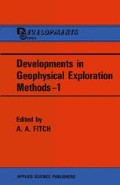Summary
Over the last twenty years the marine seismic source has evolved from a single solid chemical charge, detonated as a high explosive point source, radiating near-field destructive energy in all directions, to an areal array of low energy mechanical sources, harmless to the environment but focusing its energy in the far-field. The early attempts to control dynamite and the gradual developments in a wide variety of low energy sources emerging to replace it are described.
Comparisons of intrinsic energy, period and band limited peak pressure are made. The many influential factors affecting the radiated far-field signature are discussed and illustrated. A general assessment of sources is given. Present day technology concerned with the control and measurement of the signature radiated by low energy arrays is described and illustrated.
Access this chapter
Tax calculation will be finalised at checkout
Purchases are for personal use only
Preview
Unable to display preview. Download preview PDF.
References
JAKOSKY, J. J. and JAKOSKY, J., JNR, Characteristics of explosives for marine seismic exploration, Geophysics, 21, No. 4, 1956.
LAVERGNE, M., Emission by underwater explosives, Geophysics, 35, No. 3,1970.
JEN YON, M. K., Experimental tests andfield results obtained with underwater line charges, paper presented at the 30th meeting of the European Association of Exploration Geophysicists (EAEG), Salzburg, Austria (unpublished).
RAYLEIGH, LORD J. W., On the pressure developed in a liquid during the collapse of a spherical cavity, Philosophical Magazine, 34, 1917.
WILLIS, H. F., Underwater explosions, time interval between successive explosions, British Report WA 47.21, 1941.
CASSAND, J. and LAVERGNE, M., High resolution multi-electrode sparker, Geophys. Prospecting, 18, 1970.
KRAMER, F. S., PETERSEN, R. A. and WALTER, W. C., Seismic Energy Sources Handbook 1968, p. 40, Bendix United Geophysical Corp., Pasadena, Ca, USA, 1968.
Author information
Authors and Affiliations
Editor information
Editors and Affiliations
Rights and permissions
Copyright information
© 1979 Applied Science Publishers Ltd
About this chapter
Cite this chapter
Lugg, R. (1979). Marine Seismic Sources. In: Fitch, A.A. (eds) Developments in Geophysical Exploration Methods—1. Springer, Dordrecht. https://doi.org/10.1007/978-94-009-9224-5_5
Download citation
DOI: https://doi.org/10.1007/978-94-009-9224-5_5
Publisher Name: Springer, Dordrecht
Print ISBN: 978-94-009-9226-9
Online ISBN: 978-94-009-9224-5
eBook Packages: Springer Book Archive

